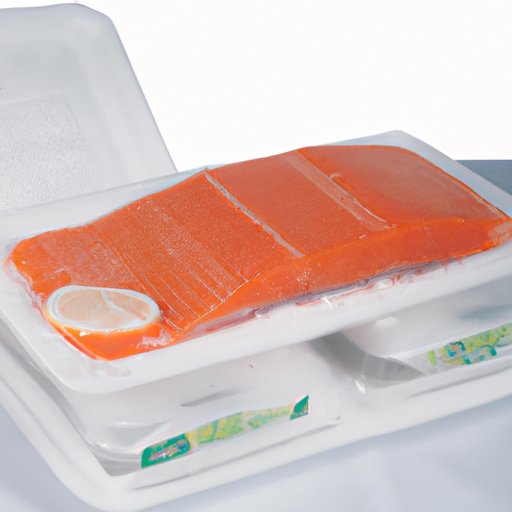Introduction
Salmon is a nutritious and delicious fish that can be enjoyed in a variety of ways. Whether you’re cooking up a filet for dinner or snacking on smoked salmon for lunch, it’s important to know how to store your salmon properly in order to ensure maximum freshness. The key is to understand how long salmon is good for in the refrigerator and how to maximize its shelf life.
A Guide to Refrigerator Storage: How Long Does Salmon Last?
When it comes to storing salmon in the refrigerator, there are several factors that can affect its shelf life. The type of salmon, the way it is packaged, and the temperature of the refrigerator are all important considerations. Generally speaking, raw salmon will last 1-2 days in the refrigerator, while cooked salmon can last up to 3-4 days.

How to Store Salmon in the Refrigerator and Maximize Its Shelf Life
In order to maximize the shelf life of salmon, there are a few tips to keep in mind when storing it in the refrigerator. Here are some of the best practices for keeping your salmon fresh:
- Wrap Salmon Tightly: Make sure to wrap the salmon tightly in plastic wrap or aluminum foil before placing it in the refrigerator. This will help to prevent air from getting in and causing spoilage.
- Place Salmon in Lowest Compartment of Fridge: Place the salmon in the lowest compartment of the refrigerator, as this is usually the coolest part. This will help to keep the salmon at an optimal temperature.
- Keep Refrigerator Clean and Free of Odors: Make sure to keep the refrigerator clean and free of odors, as these can cause the salmon to spoil more quickly.
- Check Dates on Packaged Salmon: If you’re buying pre-packaged salmon, make sure to check the expiration date to ensure that it is still safe to eat.
Maximizing Quality: The Best Way to Store Salmon in the Refrigerator
When it comes to maximizing the quality of your salmon, the type of packaging you use is just as important as the temperature of the refrigerator. There are three main types of packaging that are ideal for storing salmon in the refrigerator: vacuum sealed bags, styrofoam containers, and plastic containers.
- Vacuum Sealed Bags: Vacuum sealed bags are the best option for storing salmon in the refrigerator, as they provide an airtight seal that helps to lock in freshness and flavor. They also take up less space than other types of packaging.
- Styrofoam Containers: Styrofoam containers are another great option for storing salmon in the refrigerator. They provide insulation to help keep the salmon cold, and they offer protection from light and moisture.
- Plastic Containers: Plastic containers are also a good option for storing salmon in the refrigerator. Make sure to choose a container that is large enough to hold the salmon without crowding it, as this will help to keep it fresh.

What You Need to Know About Refrigerator Storage of Salmon
When storing salmon in the refrigerator, it’s important to remember a few key points. First, always make sure to keep the temperature of the refrigerator at a consistent level – ideally between 32°F and 40°F. Second, avoid cross-contamination by keeping raw and cooked fish separate. Finally, never leave salmon in the refrigerator for longer than 2 days after opening the package.

Refrigerator Storage Tips for Making Salmon Last Longer
If you’re not planning to use the entire package of salmon at once, there are a few tips for making it last longer in the refrigerator. First, separate the raw and cooked fish into different containers. This will help to reduce the risk of cross-contamination and food poisoning. Second, freeze any unused portions of salmon for future use. Finally, use any opened packages of salmon within 2 days of opening them.
Conclusion
Storing salmon in the refrigerator can be a tricky process, but with the right tips and techniques, you can ensure that your salmon stays fresh and flavorful. To maximize the shelf life of salmon, it’s important to keep the temperature of the refrigerator consistent, avoid cross-contamination, and use the best packaging for refrigerator storage. By following these simple tips, you can make sure that your salmon remains fresh and delicious for as long as possible.


